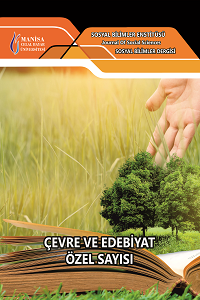Öz
Bu
derleme neonikotinoid insektisitlerin hedef olmayan organizmalar üzerindeki
zararlı etkilerini açıklamak ve bu konuda farkındalık yaratmak amacıyla
hazırlanmıştır. Son yıllarda artan nüfus ve buna bağlı olarak artan beslenme
ihtiyacını karşılamak amacıyla tarımda verimin arttırılması önem kazanmıştır. Buna bağlı olarak tarımsal alanlarda pestisit adı
verilen çeşitli koruyucu maddelerden yararlanılmaya başlanmıştır. İnsektisitler
en sık kullanılan pestisitler arasında sayılmaktadır. Zararlı böceklere karşı
kullanılan neonikotinoid insektisitler tarımda son 30 yıldır giderek artan bir
oranda kullanılmaya başlanmıştır. Bu insektisitler tarımsal alanların yanı sıra
evlerde, parklarda ve bahçelerde zararlılara karşı da yaygın şekilde
kullanılmaktadır. Neonikotinoid insektisitler çevrede geniş yayılım göstermekte
ve hedef olmayan yararlı organizmalar üzerinde birçok olumsuz etki
göstermektedir. Bu insektisitlerin zararlı etkilerinin bazı yararlı
böceklerden, kuşlara ve hatta memelilere kadar uzandığı tahmin edilmektedir.
Anahtar Kelimeler
Kaynakça
- BLACK, Scott Hoffman and VAUGHAN, Mace (2013), Pesticide causes largest mass bumble bee death on record, The Xerces Society for Invertebrate. BONMATIN, Jean M, GIORIO, C, GIROLAMII, V, GOULSON, D, KREUTZWEISER, D, P, KRUPKE, C, LIESS, M, LONG, E, MARZARO, M, MITCHELL, E, A, D, NOOME, D A, SIMON-DELSO, N and TAPPARO, A (2015) Environmental fate and exposure; neonicotinoids and fipronil, Environ. Sci. Pollut. Res., S: 22, ss. 35–67.. BREDENBERG, Al (2012), ‘’Online ‘Cool Farm’ Tool Helps Farmers Calculate Their Carbon Footprint’’, (https://inhabitat.com/online-cool-farm-tool-helps-farmers calculate-their-carbon-footprint/) (10.10.2017) CASIDA, John E and QUISTAD, Gary B (2004), Why insecticides are more toxic to insect than people, the unique toxicology of insects, Journal of Pesticide Science, S:29, ss. 81-86. EFSA (European Food Safety Authority) (2013), Conclusion on the peer review of the pesticide risk assessment for bees for the active substance clothianidin, EFSA Journal, S: 11(1), ss. 3066. EPA (Environmental Protection Agency) (2008), ‘’EPA acts to protect bees’’, (www.epa.gov/pesticides), (08.10.2017) FENG, S, KONG, Z, WANG, X, ZHAO, L and PENG, P (2004), Acute toxicity and genotoxicity of two novel pesticides on amphibian, Rana N. Hallowell, Chemosphere, S: 56, ss. 457–63. GONZALEZ-PRADAS, Emilio, URENA-AMATE, Maria D, FLORES-CESPEDES, Francisco, FERNANDEZ-PEREZ, Manuel, GARRATT, James and WILKINS, Richard J (2002), Leaching of imidacloprid and procymidone in a greenhouse of southeast of Spain, Soil Science Society of America Journal, S: 66, ss. 1821–1828. GOULSON, Dave (2013), An owerview of the environmental risks posed by neonicotinoid insecticides. Journal of Applied Ecology, S: 50, ss. 977-987. GURUR (2013), ‘’Su Kaynağı Nedir?’’, (http://www.nkfu.com/su-kaynagi-nedir/) (10.10.2017) HOPWOOD, Jeniffer, VAUGHAN, Mace, SHEPHERD, Matthew, BIDDINGER, David, MADER, Eric, BLACK, Scott Hoffman and MAZZACANO, Celeste (2012), Are Neonicotinoids Killing Bees? The Xerces Society for Invertebrate Conservation, p. 33. KATHRYN, Klarich L, NICHOLAS, Pflug C, EDEN, DeWald M, MICHELLE, Hladik L, DANA, Kolpin W, DAVID, Cwiertny M and GREGORY, LeFevre H (2017), Occurrence of neonicotinoid insecticides in finished drinking water and fate during drinking water treatment, Environ. Sci. Technol. Lett., S: 4, ss.168-173. MAIN, Anson R, HEADLEY, John V, PERU, Kerry M, MICHEL, Nicole L, CESSNA, Allan J and MORRISSEY, Christy A (2014), Widespread use and frequent detection of neonicotinoid insecticides in wet lands of Canada’s prairie pothole region, PLoS One, S: 9, e92821. MAINI, Stefano, MEDRZYCKI, Piotr and PORRINI, Claudio (2010), The puzzle of honey bee losses: a brief review, Bulletin of Insectology, S: 63, ss.153-160. MENCKE, Norbert and JESCHKE, Peter (2002), Therapy and prevention of parasitic insects in veterinary medicine using imidacloprid, Curr Top Med Chem., S: 7, ss. 701- 715. MORRISSEY, Christy A., MINEAU, Pierre, DEVRIES, James H, SÁNCHEZ-BAYO, Francisco, LIESS, Matthias, CAVALLARO, Michael C and LIBER, Karsten (2015), Neonicotinoid contamination of global surfacewaters and associated risk to aquatic invertebrates: a review, Environ. Int., S: 74, ss. 291–303. MOSER, Susan E and OBRYCKI, John J (2009), Non-target Effects of Neonicotinoid Seed Treatments; Mortality of Coccinellid Larvae Related to Zoophytophagy, Biological Control, S: 51, ss. 487-492. OSTERAUER, Raphaela and KOHLER, Heinz R (2008), Temperature-dependent effects of the pesticides thiacloprid and diazinon on the embryonic development of zebrafish (Danio rerio), Aquatic Toxicology, S: 86, ss. 485–494. ÖZTÜRK, Saffet (1990), Tarım İlaçları, Hasad Yayıncılık, Ankara, s. 523. SANCHEZ-BAYO, Francisco and HYNE, Rose V (2014), Detection and analysis of neonicotinoids in river waters—development of a passive sampler for three commonly used insecticides, Chemosphere S: 99, ss. 143–151. SEAGRAVES, Michael P and LUNDGREN, Jonathan G (2012), Effects of neonicotinoid seed treatments on soybean aphid and natural enemies, J. Pest. Sci. S: 85, ss. 125-132. SMITLEY, Dave (2016), How to protect pollinators in urban landscapes and gardens, Michigan State University Extension, Department of Entomology. STARNER, Keith and GOH, Kean D (2012), Detection of the neonicotinoid insecticide imidacloprid in surface waters of three agricultural regions of California, USA, 2010-2011. Bull. Environ. Contam. Toxicol., S: 88, ss. 316-321. TEGOWSKA, Eugenia, GRAJPEL, Barbara, WOREK, Krzysztof, WIOLCZYNSKA, Bogdana and PIECHOWICZ, Bartosz (2004), Effect of acetamipride on development and consumption of iodine by tadpole of Rana temporaria (Amphibia: Anura), Zoologica Poloiniae, S:4 ss. 181-190. TOMIZAWA, Motohiro and CASIDA, John E (2003), Selective Toxicity of neonicotinoids attributable to specificity of insect and mammalian nicotinic receptors, Annual Review of. Entomology, S:48, ss. 339-364. TOMIZAWA, Motohiro and CASIDA, John E (2005), Neonicotinoid insecticide toxicology: Mechanism of selective action, Annual Review of Pharmacology and Toxicology, S:45, ss. 247-268. UÇKUN, Miraç, Xenopus laevis İribaşlarına Thiakloprid ve Trifloksistrobin’in Akut Toksik Etkilerinin Araştırılması, Doktora Tezi, İnönü Üniversitesi Fen Bilimleri Enstitüsü, 2013. VAN DER SLUIJS, Jeroen P, SİMON-DELSO, Noa, GOULSON, Dave, MAXIM, Laura, BONMATIN, Jean-Marc and BELZUNCES, Luc P (2013), Neonicotinoids, bee disorders and the sustainability of pollinator services, Curr. Opin. Env. Sus., S: 5, ss. 293-305. VAN DIJK, Tessa C, VAN STAALDUINEN, Marja A, VAN DER SLUIJS, Jeroen P (2013), Macroinvertebrate decline in surface water polluted with imidacloprid, PLoS One, S: 8, e62374. WOOD, James T and GOULSON, Dave (2017), The environmental risks of neonicotinoid pesticides: a review of the evidence post 2013, Environ. Sci. Pollut. Res., S:24, ss. 17285–17325.
Ayrıntılar
| Birincil Dil | İngilizce |
|---|---|
| Bölüm | Makaleler |
| Yazarlar | |
| Yayımlanma Tarihi | 16 Mayıs 2018 |
| Yayımlandığı Sayı | Yıl 2018 Cilt: 16 Sayı: 1/2 |


